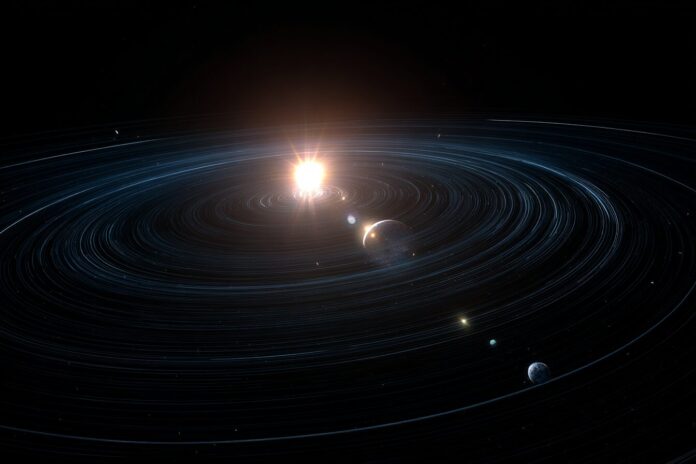Introduction
The cosmos is filled with mysteries that continue to fascinate scientists and enthusiasts alike. Every now and then, the universe presents scenarios that challenge our understanding of planetary stability and the dynamics of celestial mechanics. Most importantly, a passing star has the potential to disrupt the carefully balanced orbits of planets in our solar system. Because of this, recent simulations and studies are fundamentally reshaping our knowledge of cosmic encounters.
In addition, these studies indicate that under rare circumstances, a neighboring star could exert enough gravitational force to perturb the orbits of planets, leading to dramatic outcomes. Transitioning from theoretical discussions to computer-generated models, researchers have developed high-resolution simulations that incorporate complex gravitational interactions. Therefore, we now have a clearer picture of how even slight perturbations can cumulatively affect planetary trajectories over billions of years.
The Mechanics of a Stellar Encounter
Because stars are in constant motion within the Milky Way, their paths occasionally bring them unusually close to one another. Most importantly, as stars drift through the galaxy, close encounters can occur that have the potential to significantly alter the orbits of planets. Recent research points out that if a star with a mass comparable to our Sun were to pass within 10,000 astronomical units (AU) of our solar system, its gravitational pull might induce notable orbital changes. Besides that, the gravitational tug-of-war could stretch or distort the otherwise predictable trajectories of our celestial neighbors.
Moreover, advanced computer models are now allowing scientists to simulate these flybys in unprecedented detail. Because the solar system interacts not only with nearby objects but also with the far-reaching Oort Cloud—stretching up to 100,000 AU—the cumulative effect of minor gravitational nudges becomes significant over time. Therefore, the models illustrate that even a slight gravitational deviation might eventually lead to a domino effect, destabilizing planets from their established paths. For instance, as described in research by Science News and further explored on Science News Explores, such an encounter could alter the dynamics of planetary orbits dramatically.
Potential Outcomes of a Stellar Flyby
Most importantly, a close flyby may trigger a cascade of gravitational disturbances. For example, Mercury’s already elliptical orbit makes it especially vulnerable during such cosmic events, positioning it at a higher risk of collision with either its planetary neighbors or even the Sun. Similarly, simulations suggest that Venus and Mars might experience shifts in their orbits that could result in catastrophic collisions or gravitational ejections. Transitioning from these immediate effects, the massive gravitational field of Jupiter could further influence trajectories, potentially hurling one or more planets into interstellar space.
In addition, even Earth is not completely immune to these scenarios. Although the probability of our planet being ejected from the solar system remains extremely low—at roughly 0.2 percent over the remaining 5 billion years—these findings emphasize the dynamic nature of our cosmic environment. Therefore, while immediate concerns are minimal, the models encourage further study into the long-term stability of our planetary orbits. Notably, resources such as NDTV have highlighted these intriguing possibilities in their recent reports.
Understanding the Odds
Because the solar system has coexisted with its galactic neighbors for billions of years, the likelihood of a catastrophic ejection may seem remote but is not entirely negligible. Statistical simulations indicate that the risk of ejection or collision due to a passing star is very low, yet it is not zero. Most importantly, Mercury and Pluto exhibit relatively higher odds of experiencing significant disturbances compared to Earth. Because these estimates derive from thousands of simulation runs that incorporate both isolated and cumulative gravitational effects, they provide a realistically challenging picture of our solar system’s future.
Furthermore, these findings underscore the necessity of re-examining older models that overlooked the continual influence of passing stars. Transitioning to modern approaches, current simulations integrate the broader galactic context, yielding slightly higher risk estimates. Therefore, while the current status quo suggests that Earth remains secure, cosmic events unfolding over billions of years could alter this balance, a perspective detailed on platforms such as IFLScience.
Historical Evidence and Future Considerations
Beyond the simulations, there exists historical evidence that reinforces the potential for dramatic cosmic incidents. Rogue planets—those that wander the galaxy untethered to any star—may be remnants of similar gravitational cataclysms. Because they appear to have been expelled from their original systems, these rogue planets offer compelling proof of the occasional disruptive influence of passing stars. Most importantly, this evidence suggests that while the current configuration of our solar system is stable, it is not immune to change.
In addition, as we look toward the future, our Sun will evolve into a red giant, potentially engulfing inner planets such as Mercury and Venus. Besides that, a close stellar encounter occurring prior to this evolutionary phase could further reshape the destiny of our planetary system. Therefore, the interplay of stellar dynamics and planetary evolution embodies the enduring unpredictability of the cosmos, as mentioned in recent analytical videos on the topic.
Conclusion: Should We Worry?
Ultimately, the scientific community continues to stress that while these scenarios provide invaluable insight into cosmic dynamics, they represent events that would unfold over billions of years. Because the probability of a passing star ejecting a planet remains exceedingly low, immediate concerns are unwarranted. Most importantly, our current understanding emphasizes that while the universe is full of surprises, the slow and gradual nature of these processes means that life on Earth is safe within the foreseeable future.
Besides that, these theoretical explorations serve as a reminder of the vast scale and complexity of the cosmos. Transitioning from fear to fascination, researchers encourage ongoing study into these dynamic processes, thereby deepening our understanding of planetary stability and the nature of the universe. Therefore, while the likelihood is remote, the intriguing possibility that a passing star could one day disrupt our solar system remains an area ripe for continued exploration.



